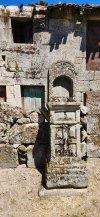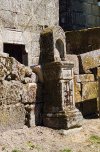You can choose to view the web site (posts #18 and #20 above) in Castellano.
See:
https://recreacionhistoria.com/o-peto-das-animas/
There is a button to select either Castellano or Gallego. Then, it is easy to use an online translator, like the Chrome default, for example. The article was very interesting and informative. Thank you for providing the link.
If I may chime in regarding the issue of indulgences. It is true that much of the Catholic Church got off on a tangent in the 1400 and 1500's regarding paying for indulgences. That was wrong. Martin Luther was right on that and many of his other criticisms of the Catholic Church. Many of these criticisms were simple statements of fact. Of course, the leaders of the Church back then did not take this kindly. The repercussions and persecutions are well documented.
The Protestant Reformation in (@) 1525 brought the misdeed of paying for indulgences to the forefront, among other errors in dogma. Given that many, if not most of these Petos de Animas (Breastplates of the Soul) appear to date to the years following the start of the Reformation, I opine that the request for donations should be seen in context.
I suggest, subject to correction as always, that the donation request was similar in context to giving a donation when lighting candles, then or now. Contrary to some sources, the smaller churches along the Camino routes, or in villages, were not all wealthy, either in land ownership, political or wealthy family sponsorship. These smaller parishes and chapels would have had to make their own way, financially.
So, seen in this context, I suggest that the donations to ask for the religious persons associated with a particular shrine / collection box to pray for the soul of the departed person referenced on the pato. This was requested in the hope that the prayers would help get the departed person's soul from Purgatory to Heaven.
Today, it is still a common practice across the Catholic world to offer prayers for the souls of departed persons. Whether a donation is offered or not, praying for the deceased souls is built into the celebration of the Holy Mass every time it is done by any priest anywhere in the world.
So, seen in context, this is not strictly a "pay to pray" scheme, or a "get out of purgatory chit." I see it more as a church or shrine seeking donations to support their livelihood. In this context, I think it not different that a poor person seeking donations at the side of the road. It is also similar in concept to a Buddhist using his or her "begging bowl" seeking alms or food.
Almsgiving is hard-wired into the religious dogma of most all of the world's major religions. I suggest that these shrines just offer a generous person a more direct connection between the money they donate and the purpose it is expected to go to.
Hope this helps the dialog.
Tom











































